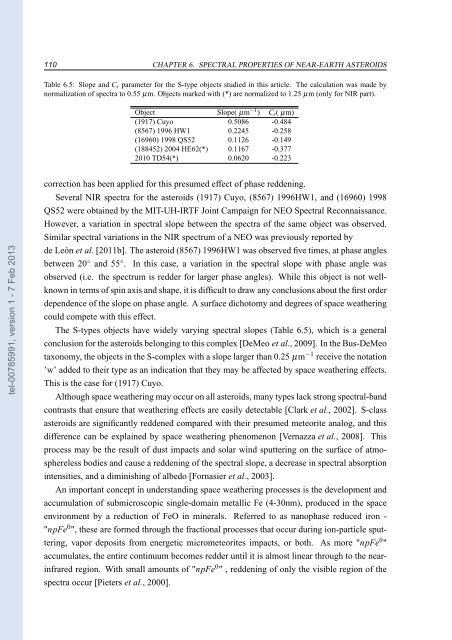Techniques d'observation spectroscopique d'astéroïdes
Techniques d'observation spectroscopique d'astéroïdes
Techniques d'observation spectroscopique d'astéroïdes
You also want an ePaper? Increase the reach of your titles
YUMPU automatically turns print PDFs into web optimized ePapers that Google loves.
110 CHAPTER 6. SPECTRAL PROPERTIES OF NEAR-EARTH ASTEROIDS<br />
Table 6.5: Slope and C s parameter for the S-type objects studied in this article. The calculation was made by<br />
normalization of spectra to 0.55 µm. Objects marked with (*) are normalized to 1.25 µm (only for NIR part).<br />
Object Slope( µm −1 ) C s ( µm)<br />
(1917) Cuyo 0.5086 -0.484<br />
(8567) 1996 HW1 0.2245 -0.258<br />
(16960) 1998 QS52 0.1126 -0.149<br />
(188452) 2004 HE62(*) 0.1167 -0.377<br />
2010 TD54(*) 0.0620 -0.223<br />
tel-00785991, version 1 - 7 Feb 2013<br />
correction has been applied for this presumed effect of phase reddening.<br />
Several NIR spectra for the asteroids (1917) Cuyo, (8567) 1996HW1, and (16960) 1998<br />
QS52 were obtained by the MIT-UH-IRTF Joint Campaign for NEO Spectral Reconnaissance.<br />
However, a variation in spectral slope between the spectra of the same object was observed.<br />
Similar spectral variations in the NIR spectrum of a NEO was previously reported by<br />
de León et al. [2011b]. The asteroid (8567) 1996HW1 was observed five times, at phase angles<br />
between 20 ◦ and 55 ◦ . In this case, a variation in the spectral slope with phase angle was<br />
observed (i.e. the spectrum is redder for larger phase angles). While this object is not wellknown<br />
in terms of spin axis and shape, it is difficult to draw any conclusions about the first order<br />
dependence of the slope on phase angle. A surface dichotomy and degrees of space weathering<br />
could compete with this effect.<br />
The S-types objects have widely varying spectral slopes (Table 6.5), which is a general<br />
conclusion for the asteroids belonging to this complex [DeMeo et al., 2009]. In the Bus-DeMeo<br />
taxonomy, the objects in the S-complex with a slope larger than 0.25 µm −1 receive the notation<br />
’w’ added to their type as an indication that they may be affected by space weathering effects.<br />
This is the case for (1917) Cuyo.<br />
Although space weathering may occur on all asteroids, many types lack strong spectral-band<br />
contrasts that ensure that weathering effects are easily detectable [Clark et al., 2002]. S-class<br />
asteroids are significantly reddened compared with their presumed meteorite analog, and this<br />
difference can be explained by space weathering phenomenon [Vernazza et al., 2008]. This<br />
process may be the result of dust impacts and solar wind sputtering on the surface of atmosphereless<br />
bodies and cause a reddening of the spectral slope, a decrease in spectral absorption<br />
intensities, and a diminishing of albedo [Fornasier et al., 2003].<br />
An important concept in understanding space weathering processes is the development and<br />
accumulation of submicroscopic single-domain metallic Fe (4-30nm), produced in the space<br />
environment by a reduction of FeO in minerals. Referred to as nanophase reduced iron -<br />
"npFe 0 ", these are formed through the fractional processes that occur during ion-particle sputtering,<br />
vapor deposits from energetic micrometeorites impacts, or both. As more "npFe 0 "<br />
accumulates, the entire continuum becomes redder until it is almost linear through to the nearinfrared<br />
region. With small amounts of "npFe 0 " , reddening of only the visible region of the<br />
spectra occur [Pieters et al., 2000].
















